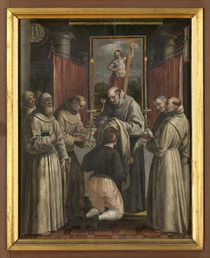The Catholic Defender: Saint Catherine of Genoa
- Donald Hartley

- Mar 26
- 4 min read
Updated: Mar 28
Deepertruth with special permission and aid with Franiciscan Media, a great team for the Lord

Going to confession one day was the turning point of Catherine’s life.
St. Catherine of Genoa is a saint who helped to shape the Catholic reformation through a hidden life of prayer and abandonment to God. Her sufferings as a young bride influenced her later life of prayer and work, and she is best known for her writings on the love of God and Purgatory.
When Catherine was born, many Italian nobles were supporting Renaissance artists and writers. The needs of the poor and the sick were often overshadowed by a hunger for luxury and self-indulgence.
Catherine’s parents were members of the nobility in Genoa. At 13, she attempted to become a nun but failed because of her age. At 16, she married Julian, a nobleman who turned out to be selfish and unfaithful. For a while she tried to numb her disappointment by a life of selfish pleasure.
St. Catherine of Siena was a Dominican tertiary and mystic who lived in Italy in the 1300s. She was known for her holiness, asceticism, and spiritual visions and was said to have received stigmata. She was also a reformer and political activist, and she was influential in religious and political affairs of the church.

One day in confession she had a new sense of her own sins and how much God loved her. She reformed her life and gave good example to Julian, who soon turned from his self-centered life of distraction. Julian’s spending, however, had ruined them financially. He and Catherine decided to live in the Pammatone, a large hospital in Genoa, and to dedicate themselves to works of charity there. After Julian’s death in 1497, Catherine took over management of the hospital.
“Lord, I make you a present of myself I do not know what to do with myself. Let me, then, Lord, make this exchange: I will place this evil being into your hands.ou are the only one who can hide it in your goodness and can so rule over me that nothing will be seen of my own proper self. On your part, you will grant your pure love, which will extinguish all other loves in me and will annihilate me and busy me so much with you that I will have no time or place for anything or anyone else.
Saint Catherine of Genoa's husband turned out to be pleasure-loving, quick-tempered, unfaithful. This was a great trial for Catarinetta; and for a while she tried to drown her disappointment in a whirl of pleasure. However, she retained her trust in God and did not give up her religious exercises.
“Let us go!” she exclaimed. “No more of earth, no more of earth!” She died two weeks later, on September fifteenth, the feast of the Exaltation of the Holy Cross.
Catherine is the patron saint of young maidens and scholars, theologians and philosophers, archivists and librarians, haberdashers and milliners, potters and wheelwrights (and many other things and places). Her name is also famously associated with the Catherine wheel firework.

Purgatory, she points out, is not a joyless place, but rather one full of joy in God, which however does not abate one particule of its excruciating suffering. Bidding farewell to her goddaughter, Tomasina Vernazza, Catherine said to her:
She wrote about purgatory which, she said, begins on earth for souls open to God. Life with God in heaven is a continuation and perfection of the life with God begun on earth.
The thieves prayed to Catherine to protect them, and when the guards looked in the bag, they saw not the small withered head of the saint, but hundreds of rose petals. When they returned to Siena, the head had re-materialized, Saint Catherine's final miracle.
Exhausted by her life of self-sacrifice, Catherine died September 15, 1510, and was canonized in 1737. The liturgical feast of Saint Catherine of Genoa is celebrated on September 15.
Catherine of Genoa was an Italian Catholic saint and mystic, admired for her work among the sick and the poor and remembered because of various writings describing both these actions and her mystical experiences.
The saint competently managed the hospital, one of Europe’s largest at the time. She served heroically during an episode of the plague in 1493, almost dying of the disease herself.
After Julian died in 1497, Catherine looked out for his illegitimate daughter, providing for her in her will. And notably, she forgave her husband’s mistress. Catherine died of an undiagnosed illness in 1510.

The body of St Catherine was exhumed eighteen months after her death. Her body was found to be perfectly intact even through her burial shroud was damp and decayed. There were many miracles that occurred at this time.
Pope Clement XII canonized Saint Catherine of Genoa in 1737.
"without the assistance of any creature, taught and governed by God alone"
"The soul", Catherine says, "presents itself to God still bound to the desires and suffering that derive from sin and this makes it impossible for it to enjoy the beatific vision of God". Catherine asserts that God is so pure and holy that a soul stained by sin cannot be in the presence of the divine majesty





















Comments